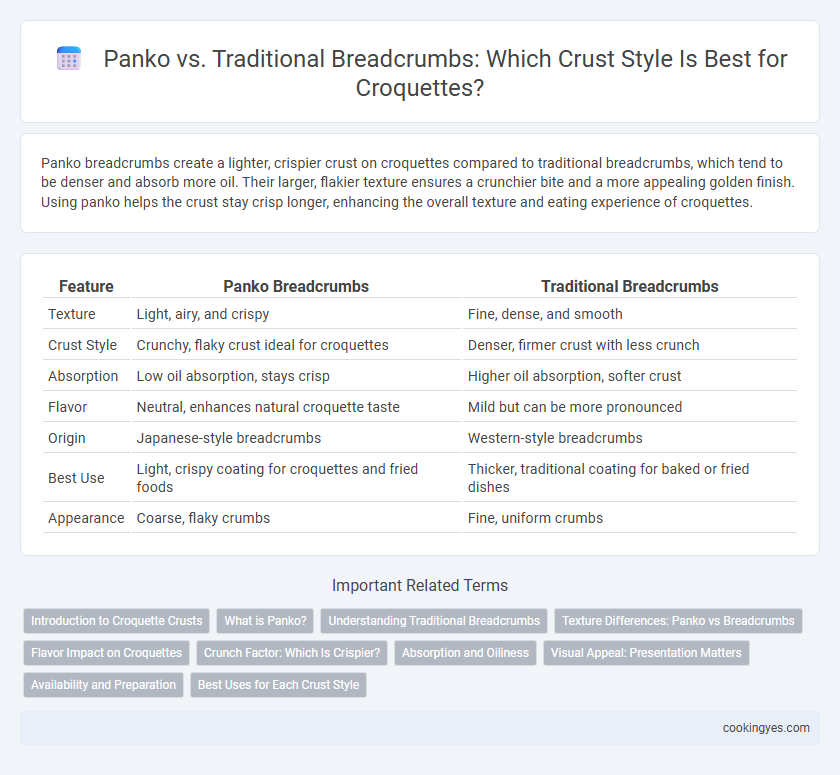Panko breadcrumbs create a lighter, crispier crust on croquettes compared to traditional breadcrumbs, which tend to be denser and absorb more oil. Their larger, flakier texture ensures a crunchier bite and a more appealing golden finish. Using panko helps the crust stay crisp longer, enhancing the overall texture and eating experience of croquettes.
Table of Comparison
| Feature | Panko Breadcrumbs | Traditional Breadcrumbs |
|---|---|---|
| Texture | Light, airy, and crispy | Fine, dense, and smooth |
| Crust Style | Crunchy, flaky crust ideal for croquettes | Denser, firmer crust with less crunch |
| Absorption | Low oil absorption, stays crisp | Higher oil absorption, softer crust |
| Flavor | Neutral, enhances natural croquette taste | Mild but can be more pronounced |
| Origin | Japanese-style breadcrumbs | Western-style breadcrumbs |
| Best Use | Light, crispy coating for croquettes and fried foods | Thicker, traditional coating for baked or fried dishes |
| Appearance | Coarse, flaky crumbs | Fine, uniform crumbs |
Introduction to Croquette Crusts
Croquette crusts vary significantly between panko and traditional breadcrumbs, with panko providing a lighter, crispier texture compared to the denser, finer crumb of traditional breadcrumbs. Panko's larger, airier flakes create a delicate crunch that enhances the croquette's exterior, making it ideal for a golden, crispy finish. Traditional breadcrumbs offer a more compact crust, contributing to a firmer, richer coating that holds up well during frying.
What is Panko?
Panko is a type of Japanese breadcrumb made from crustless white bread, resulting in larger, airier flakes compared to traditional breadcrumbs. Its unique texture creates a lighter, crispier crust ideal for croquettes, providing a delicate crunch without excessive oil absorption. Often preferred in Japanese cuisine, panko enhances the texture and appearance of fried foods, making it a superior choice for a crisp outer layer.
Understanding Traditional Breadcrumbs
Traditional breadcrumbs offer a dense and fine texture ideal for creating a sturdy, even crust on croquettes, providing a uniform golden-brown finish during frying. Made from dried or toasted bread, these crumbs absorb less oil compared to panko, resulting in a richer, less crispy outer layer. Their compact structure enhances the cohesiveness of the croquette's coating, ensuring effective moisture retention and preventing the filling from leaking during cooking.
Texture Differences: Panko vs Breadcrumbs
Panko breadcrumbs create an exceptionally light and crispy crust due to their coarser, flake-like texture, which allows for better air circulation during frying. Traditional breadcrumbs have a finer, denser texture that results in a denser, crunchier coating but can absorb more oil, making the croquette heavier. The choice between panko and traditional breadcrumbs significantly affects the mouthfeel and crispiness level of croquette crusts, with panko delivering a superior, airy crunch.
Flavor Impact on Croquettes
Panko breadcrumbs create a lighter, crunchier crust that enhances the croquette's texture without overpowering its flavor, preserving the delicate balance of fillings like mashed potatoes or seafood. Traditional breadcrumbs offer a denser, richer crust that imparts a toasty, buttery flavor, adding depth but sometimes masking subtle taste notes. Choosing between panko and traditional breadcrumbs affects both mouthfeel and flavor intensity, crucial for achieving the desired croquette experience.
Crunch Factor: Which Is Crispier?
Panko breadcrumbs create a crunchier crust for croquettes due to their larger, flakier texture that retains air pockets during frying, resulting in a lighter and crispier bite. Traditional breadcrumbs are finer and denser, producing a thicker, less crisp coating that can absorb more oil and become soggy over time. For maximizing the crunch factor, panko is the preferred choice in achieving a consistently crispy and airy croquette crust.
Absorption and Oiliness
Panko breadcrumbs absorb less oil than traditional breadcrumbs, resulting in a lighter, less greasy croquette crust. Their larger, flakier texture creates greater crispiness without excessive oil retention, enhancing the overall mouthfeel. Traditional breadcrumbs, with a finer grind, tend to soak up more oil, making croquettes denser and heavier.
Visual Appeal: Presentation Matters
Panko breadcrumbs create a lighter, airier crust with a golden, crisp texture that enhances the visual appeal of croquettes, making them look more appetizing and gourmet. Traditional breadcrumbs yield a denser, darker crust that can appear heavier and less refined on the plate. Using panko ensures a uniform, delicate crust that elevates presentation quality and entices diners with its visually striking crunch.
Availability and Preparation
Panko breadcrumbs offer a lighter, crispier crust compared to traditional breadcrumbs, making them ideal for croquettes. Panko is widely available in most supermarkets, often found in the Asian or international aisle, while traditional breadcrumbs are more common and come in various textures. Preparation with panko requires less oil absorption, resulting in a crunchier finish, whereas traditional breadcrumbs can create a denser, softer crust.
Best Uses for Each Crust Style
Panko breadcrumbs create a light, airy, and extra-crispy crust ideal for croquettes that need a delicate crunch without heaviness, perfect for seafood or vegetable fillings. Traditional breadcrumbs form a denser, more compact crust that provides a hearty texture, making them better suited for meat-filled croquettes or recipes requiring a more substantial outer layer. Choosing between panko and traditional breadcrumbs depends on the desired crust texture and the moisture content of the croquette filling.
Panko vs Traditional Breadcrumbs for crust style Infographic

 cookingyes.com
cookingyes.com